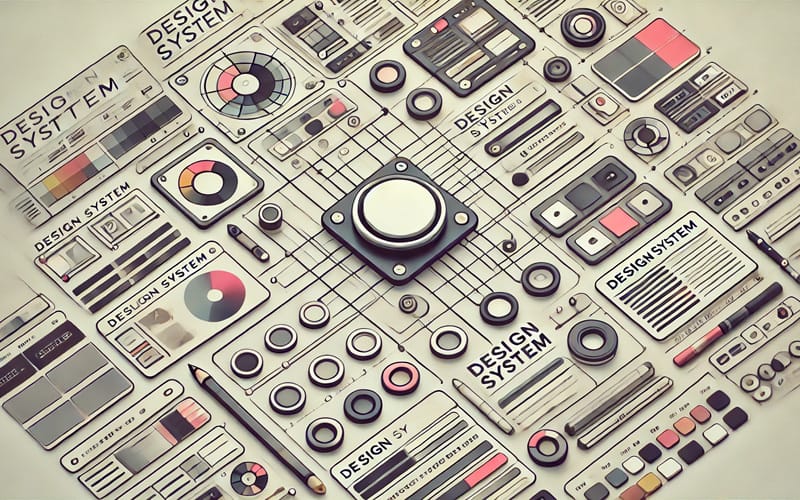DESIGN SYSTEM: THE KEY TO A COHERENT AND EVOLVING USER EXPERIENCE

The Design System has become a critical pillar in creating consistent and effective digital interfaces. Whether you are a designer, developer, or project manager, understanding and adopting this approach can transform the way you design your digital products. This article delves into the concept of a Design System, its advantages, and the key steps to implement it.
What is a Design System?
A Design System is a set of rules, principles, and resources that define the appearance and behavior of a user interface (UI). It typically includes:
- A library of reusable UI components (buttons, forms, cards, etc.).
- A style guide detailing choices on typography, colors, spacing, etc.
- Design principles that define the desired user experience.
- Guidelines for interactions (animations, transitions).
- Technical documentation explaining how to implement these components.
A Design System goes far beyond just a style guide: it aims to centralize best design and development practices to ensure a consistent user experience across all platforms and products.
Why Adopt a Design System?
Adopting a Design System has numerous advantages:
- Visual and Functional Consistency
A Design System ensures uniformity across the interfaces of a product or range of products. With each element adhering to the same visual and behavioral rules, users benefit from a seamless and intuitive experience. - Time and Productivity Gains
With a library of reusable components, design and development teams can focus more on specific features rather than recreating visual elements. - Facilitated Collaboration
By defining clear standards, the Design System fosters communication between designers and developers. Everyone speaks the same language, reducing the risk of errors and misunderstandings. - Scalability
A well-designed Design System allows for the addition of new features or adaptation of the interface without disrupting the overall consistency of the product. - Better Brand Management
The Design System acts as a foundation that ensures the company's visual identity is maintained, even as new teams or partners come on board.
How to Implement a Design System?
Creating a Design System requires time and careful organization. Here are the key steps to build it effectively:
- Inventory Existing Elements
Before creating a Design System, it is essential to analyze the current interfaces to identify inconsistencies and recurring elements. This phase helps define priorities and avoid starting from scratch. - Define Design Principles
Design principles are the foundation of your Design System. They translate the company’s values and objectives into user experience terms. For example: "Simplicity first" or "Promote accessibility." - Create a Component Library
Each component should be designed to be reusable and adaptable. For instance, a button should exist in multiple variants (size, color, state: active/inactive). These components should include:- A graphical version (in tools like Figma, Sketch, or Adobe XD).
- A coded version, integrated into a framework like React, Vue.js, or Angular.
- Detailed documentation explaining how to use them.
- Develop a Style Guide
The style guide brings together all decisions regarding colors, typography, icons, spacing, and interactions. It must be clear and accessible to all teams. - Document and Centralize
Comprehensive documentation is essential to ensure adoption of the Design System. It should explain the objectives, usage principles of components, and best practices. Tools like Storybook, Zeroheight, or Notion are commonly used for this documentation. - Implement Governance
A Design System is never static: it must evolve according to the product's needs. It is important to designate a team or responsible parties to maintain and continuously improve the Design System. - Train the Teams
To ensure adoption of the Design System, it is crucial to raise awareness among teams about its functionality and benefits. Training sessions, workshops, and demonstrations can help facilitate this process.
Examples of Famous Design Systems
Many companies have successfully adopted this approach. Some of the most well-known include:
- Material Design (Google): A Design System focused on visual hierarchy and natural interactions.
- Carbon Design System (IBM): A system designed for complex interfaces, focused on accessibility.
- Polaris (Shopify): A Design System created for e-commerce interfaces.
These examples offer an excellent source of inspiration for understanding how to effectively structure a Design System.
Conclusion
A Design System is much more than just a component library: it is a genuine strategy aimed at improving consistency, productivity, and user experience. Implementing it requires thoughtful reflection and close collaboration between designers and developers, but the benefits in terms of product quality and time-saving make it a particularly worthwhile investment.
Whether you are working on a small app or a complex platform, adopting a Design System is a step that will sustainably improve your creation and maintenance processes.
